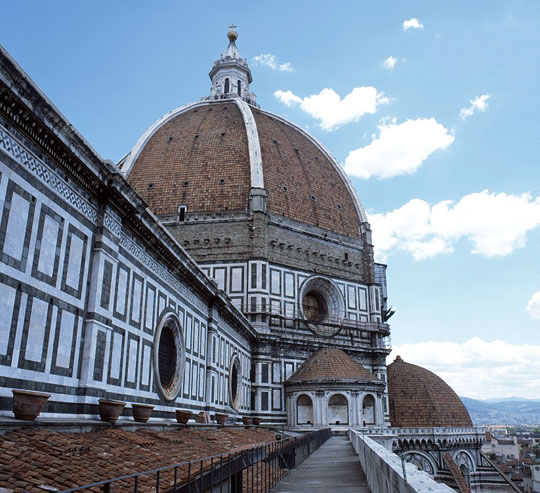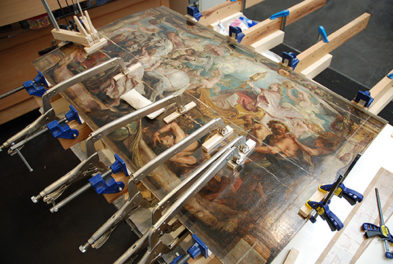Italy is full of extraordinary, breathtaking round-the-corner experiences. You round a corner in Rome and find the Pantheon. In Pisa it could be the Torre Pendente di Pisa, better known as the Leaning Tower.
When you arrive at the Florence train station, you walk down Via Panzani, turn onto Via de’ Cerretani, and just around the corner you see it: the Duomo, the cathedral church of Florence, dominated by its magnificent cupola designed by Filippo Brunelleschi and built over a 16-year period between 1420 and 1436.

View of Brunelleschi's dome from the first gallery. Photo courtesy of ECHO (European Cultural Heritage Online), Project for the Photographic Documentation of the Cupola of St. Maria del Fiore in Florence
When you first see Brunelleschi’s dome, you can’t help but wonder how such a massive structure—the first octagonal dome in history built of brick without a wooden support frame—could possibly have been constructed in the 15th century. In fact, for more than 100 years scholars have had a vision of gaining access to the archives that would provide the answer to this question, and to the many others that have been asked since the dome was first envisioned.
In 2000, the Getty Foundation, joining other participants, agreed to provide a grant to support just such an effort, begun in 1994 as the Years of the Cupola project. This database of documentary sources on the administration of Florence Cathedral during the construction of Brunelleschi’s dome incorporates unabridged archival sources on Florentine society and material culture during the Renaissance.
It includes the history of the Cathedral organization, its work site and personnel, its finances, its relationship with the clergy, and its daily routines, from the discipline of the workers to details such as the wine served on feast days. The transcription, annotation, editing, and data input of some 21,000 records provides the user with a window on medieval life, a boon for art scholars and researchers.

Gabriella Battista of the Years of the Cupola project team consulting a manuscript from the archive. Photograph courtesy of the Opera di Santa Maria del Fiore
When I was in Florence this past spring for an announcement about the Getty’s Panel Paintings Initiative, also funded by the Foundation, which focuses on the conservation of panel paintings and the training of the next generation of panel panting conservators, I had a chance to meet Peggy Haines, the highly regarded art historian who has led the development of this informative and history-making database.
Imagine my excitement as we climbed the steps in what once had been the cardinal’s palace, located on the Piazza del Duomo, to a room overlooking Brunelleschi’s masterpiece, as I watched Peggy carefully take one of the hundreds of archival books from a shelf—this one dated 1421—and as we read entries dealing with that particular day’s purchases, the workers’ assignments and accomplishments.
Then imagine historians now being able to find, as Peggy did during this project, incredible detail about every aspect of the dome’s construction, as well as archival evidence putting to rest beliefs that have been treated as fact for centuries. Legend had it, for example, that the majority of workmen who built the dome were foreigners, mostly coming from Lombardy. It turns out only a few of the workers were from outside the Florentine dominion. It was believed that Lorenzo Ghiberti, famous for the “Gates of Paradise” doors on the Duomo’s Baptistery and a Brunelleschi competitor, spent six times as much as Brunelleschi building his model of a cupola for the Duomo during the competition to select the winning architect. But, according to Peggy, that misinformation grew out of an interpretation by a Brunelleschi partisan—as documents in the archive now make clear.
Take a look for yourself here. (See the full digitized image of the page pictured below here, and the text transcription here.) Understanding Italian and Latin, or having a translator nearby, will help, but using this database to learn the context in which this incredible structure was built provides a whole new perspective for historians and scholars.

One of the 21,000 digitized documents in the archive (Codex II 2 1, fol. 177, dated June 23, 1431). Brunelleschi's name is highlighted in yellow. Written in Latin, the sentence begins: Filippum ser Brunelleschi cum salario florenorum auri centum (Filippo Brunelleschi, with a salary of 100 gold florins). Photograph courtesy of the Opera di Santa Maria del Fiore




Very interesting article about the creation of a masterpiece. I had never realized the challenge that Brunelleschi went through just to design the dome in the first place.